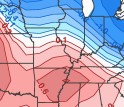|

Press Release 05-209
Model Predicts Colder Winter Temperatures in the East, Warmer in the West

Method includes data from autumn snowfall in Siberia
December 15, 2005
According to a model developed by atmospheric scientist Judah Cohen of Atmospheric and Environmental Research (AER), Inc., temperatures during Dec., Jan., and Feb. will be cold in the eastern United States and warm west of the Mississippi River.
The largest departures from normal are found in the eastern Great Lakes (darkest blue) and in the Southwest (darkest red). Cohen's model uses El Nino, recent temperature trends and Siberian snow cover in Oct, as well as sea-level pressure anomalies, in its winter forecast.
For Jan., Feb., and Mar. (at right), the model shows cold temperatures in the Northeast, the Great Lakes, and the Northern Plains and warm in the Rockies and along the West Coast.
Cohen says regions impacted by snow variability differ from those influenced by El Nino, which is often used in forecast models. "The influence of snow cover extent has the potential to complement El Nino-derived forecasts, and to advance our understanding of climate variability and its application in prediction models," he said.
Read the NSF special report on Predicting Seasonal Weather.
-NSF-

Media Contacts
Cheryl Dybas, NSF (703) 292-7734 cdybas@nsf.gov

The National Science Foundation (NSF) is an independent federal agency that
supports fundamental research and education across all fields of science and
engineering, with an annual budget of $6.06 billion. NSF funds reach all 50
states through grants to over 1,900 universities and institutions. Each year,
NSF receives about 45,000 competitive requests for funding, and makes over
11,500 new funding awards. NSF also awards over $400 million in
professional and service contracts yearly.
 Get News Updates by Email Get News Updates by Email
Useful NSF Web Sites:
NSF Home Page: http://www.nsf.gov
NSF News: http://www.nsf.gov/news/
For the News Media: http://www.nsf.gov/news/newsroom.jsp
Science and Engineering Statistics: http://www.nsf.gov/statistics/
Awards Searches: http://www.nsf.gov/awardsearch/
| 


